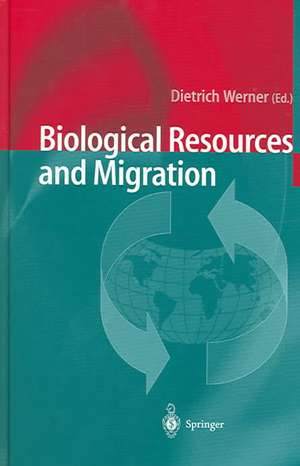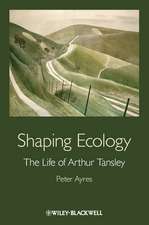Biological Resources and Migration
Editat de Dietrich Werneren Limba Engleză Hardback – 9 iun 2004
The special feature of this book is that all forms of migration - be it plant, microbial, animal or human - and their mutual impact are covered in detail. It is estimated that during the next twenty years more than one billion people will migrate from rural areas to urban districts worldwide, forced by deteriorating biological resources and with enormous consequences on the functioning of both ecosystems and such central economic areas such as trade, transport and tourism.
The contributions in this book are the result of an innovative International Conference and OECD Workshop aimed at triggering off the interdisciplinary dialogue between natural scientists and socioeconomists.
| Toate formatele și edițiile | Preț | Express |
|---|---|---|
| Paperback (1) | 1221.07 lei 6-8 săpt. | |
| Springer Berlin, Heidelberg – 30 noi 2010 | 1221.07 lei 6-8 săpt. | |
| Hardback (1) | 1227.67 lei 6-8 săpt. | |
| Springer Berlin, Heidelberg – 9 iun 2004 | 1227.67 lei 6-8 săpt. |
Preț: 1227.67 lei
Preț vechi: 1497.16 lei
-18% Nou
Puncte Express: 1842
Preț estimativ în valută:
234.91€ • 245.93$ • 194.38£
234.91€ • 245.93$ • 194.38£
Carte tipărită la comandă
Livrare economică 05-19 aprilie
Preluare comenzi: 021 569.72.76
Specificații
ISBN-13: 9783540214700
ISBN-10: 3540214704
Pagini: 392
Ilustrații: XXIX, 363 p.
Dimensiuni: 155 x 235 x 27 mm
Greutate: 0.73 kg
Ediția:2004
Editura: Springer Berlin, Heidelberg
Colecția Springer
Locul publicării:Berlin, Heidelberg, Germany
ISBN-10: 3540214704
Pagini: 392
Ilustrații: XXIX, 363 p.
Dimensiuni: 155 x 235 x 27 mm
Greutate: 0.73 kg
Ediția:2004
Editura: Springer Berlin, Heidelberg
Colecția Springer
Locul publicării:Berlin, Heidelberg, Germany
Public țintă
ResearchCuprins
1 The Rice Genepool and Human Migrations.- 2 Movement of Rice Germplasm Around the World.- 3 Potential for Gene Flow from Cultivated Wheat to Weedy Relatives in the Great Plains of North America.- 4 Humans, Climate, and Plants: the Migration of Crested Wheatgrass and Smooth Bromegrass to the Great Plains of North America.- 5 Biogeography, Local Adaptation, Vavilov, and Genetic Diversity in Soybean.- 6 Migration of a Grain Legume, Phaseolus vulgaris, in Europe.- 7 Forest History in Europe.- 8 Forest Biological Resources in the Amazon Basin.- 9 Migration of Knowledge Leads to Floristic Development in Myanmar.- 10 Tracking Parasitoids at the Farmland Field Scale Using Microsatellite Markers.- 11 Interhemispheric Transport of Viable Fungi and Bacteria from Africa to the Caribbean with Soil Dust.- 12 Be a Virus, See the World.- 13 Species Delineation and Biogeography of Symbiotic Bacteria Associated with Cultivated and Wild Legumes.- 14 Micro-spatial Distribution of Bacteria in the Rhizosphere.- 15 Colonization of Some Polish Soils by Azotobacter spp. at the Beginning and at the End of the 20th Century.- 16 Estimation of Biotic and Abiotic Factors That Affect Migration of Rhizobia.- 17 Indigenous Strains of Rhizobia and Their Performance in Specific Regions of India.- 18 Migration of Aquatic Invertebrates.- 19 Migration of Fishery Resources in the World’s Oceans.- 20 Migration of Marine Mammals.- 21 The “Global Register of Migratory Species” — First Results of Global GIS Analysis.- 22 Coupled Dynamics of Lemmings and Long-Distance Migratory Birds.- 23 Israel — an Intercontinental Highway for Migrating Birds.- 24 Contrasting Molecular Markers Reveal: Gene Flow via Pollen Is Much More Effective Than Gene Flow Via Seeds.- 25 Principal Changes of Ecological Migrationand Dispersal: Nature Conservation Consequences.- 26 Agronomical Practices Maximizing Water Use.- 27 Soil Degradation and Land Use.- 28 Migration Towards the Cities: Measuring the Effects of Urban Expansion in Rural-Urban Interface by GIS and RS Technology.- 29 Population Shifts and Migration in the Sahel and Sub-Sudan Zone of West Africa Reviewed from the Aspect of Human Carrying Capacity.- 30 Desertification and Human Migration.- 31 Airborne Migration of Obligate Nomads Demonstrates Gene Flow Across Eurasia.- 32 Discussion Sessions.
Recenzii
From the reviews:
"This volume is the product of a recent … conference and workshop at Phillips University in Marburg, Germany, which brought together more than 100 scientists from 24 nations to discuss the movement of organisms and resources across landscapes and seascapes. Biological Resources and Migration emphasizes the involvement of humans in ecological systems. This characteristic of the book may appeal especially to European landscape ecologists … . landscape ecologists are likely to find something in Biological Resources and Migration pertinent to their research … ." (Kevin M. Potter, Landscape Ecology, Vol. 21, 2006)
"This volume is the product of a recent … conference and workshop at Phillips University in Marburg, Germany, which brought together more than 100 scientists from 24 nations to discuss the movement of organisms and resources across landscapes and seascapes. Biological Resources and Migration emphasizes the involvement of humans in ecological systems. This characteristic of the book may appeal especially to European landscape ecologists … . landscape ecologists are likely to find something in Biological Resources and Migration pertinent to their research … ." (Kevin M. Potter, Landscape Ecology, Vol. 21, 2006)
Textul de pe ultima copertă
Migration is a global and ubiquitous phenomenon. A large percentage of our cultivated land in industrialized as well as in developing countries are covered with migrated or introduced plants. But also in natural habitats and communities, migration of animals, plants and microorganisms plays a key role in the functioning or threat to the present ecosystems.
The special feature of this book is that all forms of migration - be it plant, microbial, animal or human - and their mutual impact are covered in detail. It is estimated that during the next twenty years more than one billion people will migrate from rural areas to urban districts worldwide, forced by deteriorating biological resources and with enormous consequences on the functioning of both ecosystems and such central economic areas such as trade, transport and tourism.
The contributions in this book are the result of an innovative International Conference and OECD Workshop aimed at triggering off the interdisciplinary dialogue between natural scientists and socioeconomists.
The special feature of this book is that all forms of migration - be it plant, microbial, animal or human - and their mutual impact are covered in detail. It is estimated that during the next twenty years more than one billion people will migrate from rural areas to urban districts worldwide, forced by deteriorating biological resources and with enormous consequences on the functioning of both ecosystems and such central economic areas such as trade, transport and tourism.
The contributions in this book are the result of an innovative International Conference and OECD Workshop aimed at triggering off the interdisciplinary dialogue between natural scientists and socioeconomists.
Caracteristici
Encompasses plant, microbial, animal, and human migration













